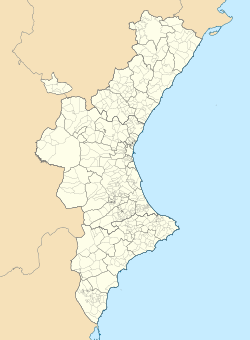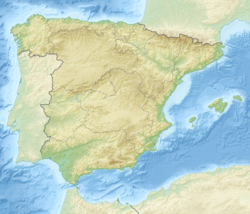Cueva de Bolomor, or Bolomor Cave, is an archaeological site near Tavernes de la Valldigna in the Valencian Community, Spain. It was occupied over a long period of time, between 350,000 and 120,000 years ago.
Cova del Bolomor (Catalan) | |
 Parietal fragment of Neanderthal, 130,000 yrs. old | |
| Location | Tavernes de la Valldigna |
|---|---|
| Region | Valencian Community |
| Coordinates | 39°03′35″N 0°15′00″W / 39.0598°N 0.2499°W |
| Altitude | 100 m (328 ft)[1] |
| Type | Intermittent settlement |
| History | |
| Periods | late Middle/early Late Pleistocene |
| Site notes | |
| Excavation dates | since 1989 |
| Website | www |
Four Neanderthal remains have been recovered in excavations that were begun in 1989: a fragment of a fibula, two teeth, and a nearly complete parietal bone from an adult. All date from the late Middle/early Late Pleistocene. The thickness of the cortical bone in the fibula indicates it came from non-modern man.[2]
Description
editThe cave is located in the La Valldigna valley, which is demarcated by the Les Creus mountain range to the north, whose highly eroded reliefs slope towards the valley, and the Mondúver range to the south. The valley is covered by sediments from the Quaternary period, and opens in the east to a marshy landscape with dunes, which connects to the coastal Mediterranean plain. The Cueva de Bolomor is on the right side of a cliff; it is a karst cave[3] at 100 metres (330 ft) above sea level,[1] surrounded by karstified hills.[3]
The cave today is more a rock shelter, of about 35 metres (115 ft) in length and 17 metres (56 ft) wide, and 20 metres (66 ft) deep with an irregular interior. Formerly, it was a much wider cave, before its dome fell in (probably due to seismic activity). Today's mouth of the cave overhangs the valley and offers a view of the coastal area, including the town of Cullera.[3]
Occupation and remains
editArchaeologists recognize a stratigraphy of 17 layers, dated between 350 and 121,000 years ago.[1] Three main periods of occupation are recognized: 350,000 years ago, 200,000 to 150,000 years ago, and 120,000 years ago.[4] Human occupants ate a wide variety of animals,[5] including ungulates of all sizes,[1] besides tortoises[6] and birds.[7] Throughout the occupation, they ate young elephants.[1] A relative rarity for the Middle Pleistocene is the frequency with which the remains of rabbits, marked with cuts, are found; such small, quick prey is unusual for the period, and is most likely a specific feature of a unique locality.[8]
Any prey, including young elephants, would have had to be carried up the steep 100-metre (330 ft) slope.[1] Flake production dominated the flint technology, fire was habitually used, and there was lithic recycling; the Levallois technique was not often used, and no handaxes were found. It is postulated that the site represents a transition from an Acheulean to a post-Acheulean mode of living,[1] which may have taken place between Marine Isotope Stages 9 and 7. Bolomor is one of "numerous European sites [that] attest new technological behavior oriented toward long and complex knapping methods, with long and complex repetitive core reduction, predetermined flake shape, and tool standardization".[9] Layers with scrapers and denticulate tools alternate.[10] Fifteen hearths, in age ranging between 250,000 and 100,000 years old, are being studied.[11] Some of the hearths were lined with stone.[12]
History of the research
editThe site has been excavated annually since 1989, during a 30-day period. Research is supported by the Prehistoric Investigation Service of the Valencian Council, and the material deposited in the Prehistory Museum of Valencia.[3]
See also
editReferences
editNotes
edit- ^ a b c d e f g Barkai & Gopher 2013, pp. 130–132.
- ^ Arsuaga et al. 2012.
- ^ a b c d "The Formation of the Cave" 2019.
- ^ "Camp sites" 2019.
- ^ Blasco & Fernández Paris 2012.
- ^ Blasco 2008.
- ^ Blasco & Fernández Paris 2009.
- ^ Stiner 2013, p. 292.
- ^ Moncel et al. 2011, p. 38.
- ^ De la Torre, Martínez-Moreno & Mora 2013, p. 324.
- ^ "Use of fire" 2019.
- ^ Roebroeks, Villa & Trinkaus 2011, p. 5210.
Bibliography
edit- Arsuaga, Juan Luis; Fernández Peris, Josep; Gracia-Téllezad, Ana; Quama, Rolf; Carretero, José Miguel; González, Virginia Barciela; Blasco, Ruth; Cuartero, Felipe; Sañudo, Pablo (2012). "Fossil human remains from Bolomor Cave (Valencia, Spain)". Journal of Human Evolution. 62 (5): 629–639. doi:10.1016/j.jhevol.2012.02.002. PMID 22440746.
- Barkai, Ran; Gopher, Avi (2013). "Cultural and Biological Transformation in the Middle Pleistocene Levant: A View from Qesem Cave, Israel". In Akazawa, Takeru; Nishiaki, Yoshihiro; Aoki, Kenichi (eds.). Dynamics of Learning in Neanderthals and Modern Humans, Volume 1: Cultural Perspectives. Springer. pp. 115–140. ISBN 9784431545118.
- Blasco, R. (2008). "Human Consumption of Tortoises in Level IV of Bolomor Cave (Valencia, Spain)". Journal of Archaeological Science. 35 (10): 2839–2848. doi:10.1016/j.jas.2008.05.013.
- Blasco, R.; Fernández Paris, J. (2009). "Middle Pleistocene Bird consumption at Level XI of Bolomor Cave (Valencia, Spain)". Journal of Archaeological Science. 36 (10): 2213–2223. doi:10.1016/j.jas.2009.06.006.
- Blasco, R.; Fernández Paris, J. (2012). "A uniquely broad spectrum diet during the Middle Pleistocene at Bolomor Cave (Valencia, Spain)". Quaternary International. 252: 16–31. Bibcode:2012QuInt.252...16B. doi:10.1016/j.quaint.2011.03.019.
- "Camp sites". Cova del Bolomor. Diputación Provincial de Valencia. 2019. Retrieved 15 August 2019.
- Moncel, Marie-Hélène; Moigne, Anne-Marie; Sam, Youssef; Combier, Jean (2011). "The Emergence of Neanderthal Technical Behavior: New Evidence from Orgnac3 (Level1, MIS8), Southeastern France". Current Anthropology. 52 (1): 37–75. doi:10.1086/658179. S2CID 145440493.
- Roebroeks, Wil; Villa, Paola; Trinkaus, Erik (2011). "On the earliest evidence for habitual use of fire in Europe". Proceedings of the National Academy of Sciences of the United States of America. 108 (13): 5209–5214. Bibcode:2011PNAS..108.5209R. doi:10.1073/pnas.1018116108. JSTOR 41125678. PMC 3069174. PMID 21402905.
- Stiner, Mary C. (2013). "An Unshakable Middle Paleolithic?: Trends versus Conservatism in the Predatory Niche and Their Social Ramifications". Current Anthropology. 54 (S8): 288–304. doi:10.1086/673285. JSTOR 10.1086/673285. S2CID 86879397.
- "The Formation of the Cave". Cova del Bolomor. Diputación Provincial de Valencia. 2019. Retrieved 15 August 2019.
- De la Torre, Ignacio; Martínez-Moreno, Jorge; Mora, Rafael (2013). "Change and Stasis in the Iberian Middle Paleolithic: Considerations on the Significance of Mousterian Technological Variability". Current Anthropology. 54 (S8): 320–336. doi:10.1086/673861. JSTOR 10.1086/673861. S2CID 54651204.
- "Use of fire". Cova del Bolomor. Diputación Provincial de Valencia. 2019. Retrieved 15 August 2019.
Further reading
edit- Fernández Paris, J.; Guillem Catatayud, P. M.; Martinez Valle, R. (1997). Cova del Bolomor. El primers habitants de les terres valencianes. Valencia: Diputación Provincial de Valencia/Museu de Prehistoria.


